ae940634dea7a4e5786984fe7e24edb6.ppt
- Количество слайдов: 96
 Applied cognitive psychology Social psychology Therapy SLA Morals - religion
Applied cognitive psychology Social psychology Therapy SLA Morals - religion
 Attention! u Friday: u 8 -10: North 6. 87 u 10 -12: South 4 -429 u 12 -18: North 6. 87
Attention! u Friday: u 8 -10: North 6. 87 u 10 -12: South 4 -429 u 12 -18: North 6. 87
 New implicit methods u IAT – Implicit Association Test u LIB (Linguistic Intergroup Bias) u Affective priming u The visual-probe test u Go-No. Go tasks u Extrinsic affective Simon Task u Emotional Stroop
New implicit methods u IAT – Implicit Association Test u LIB (Linguistic Intergroup Bias) u Affective priming u The visual-probe test u Go-No. Go tasks u Extrinsic affective Simon Task u Emotional Stroop
 Social cognition u La Piére”s Chinese couple in the USA – Explicit attitudes cannot predict actual behaviour
Social cognition u La Piére”s Chinese couple in the USA – Explicit attitudes cannot predict actual behaviour
 Applied implicit cognition u Social cognition: – The IAT (Greenwald, Mc. Gee and Schwartz, 1998) – Implicit Association test – Applied to attitudes, stereotypes, selfesteem u “the introspectively unidentified (or inaccurately identified) trace of past experience that mediates R” where R refers to the category of responses that are assumed to be influenced by that construct
Applied implicit cognition u Social cognition: – The IAT (Greenwald, Mc. Gee and Schwartz, 1998) – Implicit Association test – Applied to attitudes, stereotypes, selfesteem u “the introspectively unidentified (or inaccurately identified) trace of past experience that mediates R” where R refers to the category of responses that are assumed to be influenced by that construct
 The implicit association test BUTTON A Women (names or faces) BUTTON B Men (names or faces)
The implicit association test BUTTON A Women (names or faces) BUTTON B Men (names or faces)
 The implicit association test BUTTON A Positive traits (wonderful, glorious) BUTTON B Negative traits (horrible)
The implicit association test BUTTON A Positive traits (wonderful, glorious) BUTTON B Negative traits (horrible)
 The implicit association test BUTTON A Women (names or faces) Positive traits (wonderful, glorious) BUTTON B Men (names or faces) Negative traits (horrible)
The implicit association test BUTTON A Women (names or faces) Positive traits (wonderful, glorious) BUTTON B Men (names or faces) Negative traits (horrible)
 Validity Less fakeable – unless done various times u Does not always correlate with reported measures – which one is true? u
Validity Less fakeable – unless done various times u Does not always correlate with reported measures – which one is true? u
 Disadvantages u Sometimes arbitrary categories have to be chosen, no natural contrasts exist – Spiders – Cocaine u Unipolar versions – there is simply one category and a control condition
Disadvantages u Sometimes arbitrary categories have to be chosen, no natural contrasts exist – Spiders – Cocaine u Unipolar versions – there is simply one category and a control condition
 The implicit association test BUTTON A Spider names (black widow, tarantula) Positive words (wonderful, glorious) BUTTON B Negative words (horrible)
The implicit association test BUTTON A Spider names (black widow, tarantula) Positive words (wonderful, glorious) BUTTON B Negative words (horrible)
 The implicit association test BUTTON A Positive words (wonderful, glorious) BUTTON B Spider names (black widow, tarantula) Negative words (horrible)
The implicit association test BUTTON A Positive words (wonderful, glorious) BUTTON B Spider names (black widow, tarantula) Negative words (horrible)
 The implicit association test BUTTON A Cat names (Siamese, Persian) Positive words (wonderful, glorious) BUTTON B Negative words (horrible)
The implicit association test BUTTON A Cat names (Siamese, Persian) Positive words (wonderful, glorious) BUTTON B Negative words (horrible)
 The implicit association test BUTTON A Positive words (wonderful, glorious) BUTTON B Cat names (Siamese, Persian) Negative words (horrible)
The implicit association test BUTTON A Positive words (wonderful, glorious) BUTTON B Cat names (Siamese, Persian) Negative words (horrible)
 Basic idea
Basic idea
 Race and prejudice u The willing and able problem – Self report measures are transparent to most people – Remember the Chinese couple travelling through America.
Race and prejudice u The willing and able problem – Self report measures are transparent to most people – Remember the Chinese couple travelling through America.
 white black desirable undesirable Jamal Sue-Ellen wonderful disgusting
white black desirable undesirable Jamal Sue-Ellen wonderful disgusting
 Explicit measures u Semantic differential – 7 point – Beautiful – ugly – Pleasant – unpleasant – good – bad – Honest – dishonest – Nice - awful u Feeling thermometer
Explicit measures u Semantic differential – 7 point – Beautiful – ugly – Pleasant – unpleasant – good – bad – Honest – dishonest – Nice - awful u Feeling thermometer
 u Explicit and implicit measures – sometimes correlate (Dovidio et al, 1997) – Sometimes they don’t (Greenwald et al. 1998) u Actual behaviour (interaction with black experimenter) – correlates slightly more significantly with implicit measures (0. 39) than explicit ones (0. 33) u but in this study the two measures (implicit and explicit) correlate
u Explicit and implicit measures – sometimes correlate (Dovidio et al, 1997) – Sometimes they don’t (Greenwald et al. 1998) u Actual behaviour (interaction with black experimenter) – correlates slightly more significantly with implicit measures (0. 39) than explicit ones (0. 33) u but in this study the two measures (implicit and explicit) correlate
 Learning attitudes u Olson & Fazio empathic (2001) cruel
Learning attitudes u Olson & Fazio empathic (2001) cruel
 Attitudes u IAT task – positive love vs negative death
Attitudes u IAT task – positive love vs negative death
 The Bean. Fest Game u Faizio, Eiser and Shook – Imgaine you’re on a new planet and have to live off beans. You have an energy of 100 initially, which decreases if you eat bad beans or do not eat at all, and increases if you eat. Your goal is to survive on the planet. – With time on every trial you lose -1 – You gain +10 with good beans – You lose -10 with bad beans
The Bean. Fest Game u Faizio, Eiser and Shook – Imgaine you’re on a new planet and have to live off beans. You have an energy of 100 initially, which decreases if you eat bad beans or do not eat at all, and increases if you eat. Your goal is to survive on the planet. – With time on every trial you lose -1 – You gain +10 with good beans – You lose -10 with bad beans


 Learning attitudes u Luupites and Niffites – They were told different stories about Luupites and Niffites – There were names to the different categories u Positive u and negative nouns Gregg, A. P. , Banaji, M. R. , & Seibt, B. (2006). Easier made than undone: the asymmetric malleability of automatic preferences. Journal of Personality and Social Psychology, 90, 1– 20.
Learning attitudes u Luupites and Niffites – They were told different stories about Luupites and Niffites – There were names to the different categories u Positive u and negative nouns Gregg, A. P. , Banaji, M. R. , & Seibt, B. (2006). Easier made than undone: the asymmetric malleability of automatic preferences. Journal of Personality and Social Psychology, 90, 1– 20.
 LIB u The Linguistic intergroup bias – the tendency to describe stereotypic events in more abstract terms than counterstereotypic events. u Distancing from the self?
LIB u The Linguistic intergroup bias – the tendency to describe stereotypic events in more abstract terms than counterstereotypic events. u Distancing from the self?
 Abstract - concrete u Descriptive action verbs (hit) – refer to objective descriptions of observable behaviors that have a clear beginning and end u interpretive action verbs (hurt) – describe a general class of behaviors and have positive or negative connotations
Abstract - concrete u Descriptive action verbs (hit) – refer to objective descriptions of observable behaviors that have a clear beginning and end u interpretive action verbs (hurt) – describe a general class of behaviors and have positive or negative connotations
 Abstract - concrete u state verbs (hate) – refer to enduring states without a clear beginning or ending u adjectives (is violent) – describe highly abstract personal dispositions
Abstract - concrete u state verbs (hate) – refer to enduring states without a clear beginning or ending u adjectives (is violent) – describe highly abstract personal dispositions
 Jim Jones hit the guy. Jim Jones hurts the guy. Jim Jones hates the guy. Jim Jones is violent.
Jim Jones hit the guy. Jim Jones hurts the guy. Jim Jones hates the guy. Jim Jones is violent.
 Jim Jones hit the guy. Jim Jones hurts the guy. Jim Jones hates the guy. Jim Jones is violent.
Jim Jones hit the guy. Jim Jones hurts the guy. Jim Jones hates the guy. Jim Jones is violent.
 She is violent. She hit the guy.
She is violent. She hit the guy.
 Priming
Priming
 Lexical Decision Task u Press YES or NO for whether the following is a real word in English: SLEEP HOUSE BRUKE NURSE NOIK u Non-words (BRUKE) are ‘fillers’ – Just to check the subject is paying attention – We only look at real words FAST response = easy to access (450 msec) u SLOW response = hard to access (500 msec) u
Lexical Decision Task u Press YES or NO for whether the following is a real word in English: SLEEP HOUSE BRUKE NURSE NOIK u Non-words (BRUKE) are ‘fillers’ – Just to check the subject is paying attention – We only look at real words FAST response = easy to access (450 msec) u SLOW response = hard to access (500 msec) u
 What affects lexical access time? u 1. Word Frequency u High frequency words = common words (cat, mother, house) u Low frequency words = uncommon words (accordion, compass) u High frequency are faster to access than Low frequency u even when they’re balanced on other features (e. g. length) – E. g. Pen vs. Pun – Rubenstein et al. (1970)
What affects lexical access time? u 1. Word Frequency u High frequency words = common words (cat, mother, house) u Low frequency words = uncommon words (accordion, compass) u High frequency are faster to access than Low frequency u even when they’re balanced on other features (e. g. length) – E. g. Pen vs. Pun – Rubenstein et al. (1970)
 The Logogen Model Morton (1969) u Accounts for the frequency effect u The lexical entry for each word comes with a logogen u The lexical entry only becomes available once the logogen ‘fires’ u When does a logogen fire? – When you read/hear the word
The Logogen Model Morton (1969) u Accounts for the frequency effect u The lexical entry for each word comes with a logogen u The lexical entry only becomes available once the logogen ‘fires’ u When does a logogen fire? – When you read/hear the word
 Think of a logogen as being like a ‘strength-o-meter’ at a fairground When the bell rings, the logogen has ‘fired’
Think of a logogen as being like a ‘strength-o-meter’ at a fairground When the bell rings, the logogen has ‘fired’
![‘cat’ [kæt] • what makes the logogen fire? – seeing/hearing the word • what ‘cat’ [kæt] • what makes the logogen fire? – seeing/hearing the word • what](https://present5.com/presentation/ae940634dea7a4e5786984fe7e24edb6/image-37.jpg) ‘cat’ [kæt] • what makes the logogen fire? – seeing/hearing the word • what happens once the logogen has fired? – access to lexical entry!
‘cat’ [kæt] • what makes the logogen fire? – seeing/hearing the word • what happens once the logogen has fired? – access to lexical entry!
![‘cat’ [kæt] • So how does this help us to explain the frequency effect? ‘cat’ [kæt] • So how does this help us to explain the frequency effect?](https://present5.com/presentation/ae940634dea7a4e5786984fe7e24edb6/image-38.jpg) ‘cat’ [kæt] • So how does this help us to explain the frequency effect? – High frequency words have a lower threshold for firing –E. g. cat vs. cot ‘cot’ [kot] Low freq takes longer
‘cat’ [kæt] • So how does this help us to explain the frequency effect? – High frequency words have a lower threshold for firing –E. g. cat vs. cot ‘cot’ [kot] Low freq takes longer
 What affects lexical access time? u 2. Semantic Priming Effects – (Meyer & Schvandeveldt, 1971) u Subject sees 2 words u Must say YES or NO whether both are real words SLOW – doctor grass … because nurse FAST – doctor nurse is already ‘warmed up’ by having just activated doctor
What affects lexical access time? u 2. Semantic Priming Effects – (Meyer & Schvandeveldt, 1971) u Subject sees 2 words u Must say YES or NO whether both are real words SLOW – doctor grass … because nurse FAST – doctor nurse is already ‘warmed up’ by having just activated doctor
 Spreading Activation Model cradle baby bed hospital nurse dentist doctor heat delirium sun green grass mammal bird canary rain fever animal yellow ostrich
Spreading Activation Model cradle baby bed hospital nurse dentist doctor heat delirium sun green grass mammal bird canary rain fever animal yellow ostrich
 Spreading Activation Model cradle baby bed hospital nurse dentist doctor heat delirium sun green grass mammal bird canary rain fever animal yellow ostrich
Spreading Activation Model cradle baby bed hospital nurse dentist doctor heat delirium sun green grass mammal bird canary rain fever animal yellow ostrich
 Semantic Network cradle baby bed hospital nurse dentist doctor heat delirium sun green grass mammal bird canary rain fever animal yellow ostrich
Semantic Network cradle baby bed hospital nurse dentist doctor heat delirium sun green grass mammal bird canary rain fever animal yellow ostrich
 Fits nicely with Logogen Model u Each of the nodes in the network has a logogen with it u When fires we read doctor, its logogen = doctor gets ‘activated’ u The activation from doctor spreads to nurse, this lowers the threshold for nurse – so make nurse faster to access
Fits nicely with Logogen Model u Each of the nodes in the network has a logogen with it u When fires we read doctor, its logogen = doctor gets ‘activated’ u The activation from doctor spreads to nurse, this lowers the threshold for nurse – so make nurse faster to access
![‘doctor’ [doktə] • spreading activation from doctor lowers the threshold for nurse to fire ‘doctor’ [doktə] • spreading activation from doctor lowers the threshold for nurse to fire](https://present5.com/presentation/ae940634dea7a4e5786984fe7e24edb6/image-44.jpg) ‘doctor’ [doktə] • spreading activation from doctor lowers the threshold for nurse to fire – So nurse take less time to fire ‘nurse’ [nə: s] Spreading activation network doctor nurse docto nurse
‘doctor’ [doktə] • spreading activation from doctor lowers the threshold for nurse to fire – So nurse take less time to fire ‘nurse’ [nə: s] Spreading activation network doctor nurse docto nurse
 Homophobia u Homophobic individuals – are threatened or sickened by their own personal attraction to gay individuals – somewhat odd and likely false to suggest that the phobic individual harbors a secret attraction to the phobic object (e. g. , a snake in the case of snake phobia u Freud, S. (1936). The problem of anxiety. New York: W. W. Norton & Company.
Homophobia u Homophobic individuals – are threatened or sickened by their own personal attraction to gay individuals – somewhat odd and likely false to suggest that the phobic individual harbors a secret attraction to the phobic object (e. g. , a snake in the case of snake phobia u Freud, S. (1936). The problem of anxiety. New York: W. W. Norton & Company.
 u Adams et al. – Homophobic men (versus non-homophobic men) became physiologically aroused (i. e. , had increased penile tumescence) when presented with short video clips of gay men involved in sexual activity – (only half of them!) u Shields & Harriman, 1984 – homophobic men exhibit physiological signs of fear and anxiety while viewing pictures of gay men – similar to that exhibited by spider phobics when viewing spider stimuli
u Adams et al. – Homophobic men (versus non-homophobic men) became physiologically aroused (i. e. , had increased penile tumescence) when presented with short video clips of gay men involved in sexual activity – (only half of them!) u Shields & Harriman, 1984 – homophobic men exhibit physiological signs of fear and anxiety while viewing pictures of gay men – similar to that exhibited by spider phobics when viewing spider stimuli
 u Defensie and non-defensive homophobia types – high homophobia in the context of high levels of self-deception should take a defensive form – low levels of self-deception should take a non-defensive form – Individual di. Verences in self-deception correlate positively with unrealistic selfportrayals in self-report
u Defensie and non-defensive homophobia types – high homophobia in the context of high levels of self-deception should take a defensive form – low levels of self-deception should take a non-defensive form – Individual di. Verences in self-deception correlate positively with unrealistic selfportrayals in self-report
 phobic participants (i. e. , spider, snake, and bloodinjection phobias) choose to view phobic objects for a shorter time than non -phobic individuals u Participants had to rate the pleasentness of pictures of heterosexual or homosexual pairs in romantic contexts – actually the measure taken was viewing time u
phobic participants (i. e. , spider, snake, and bloodinjection phobias) choose to view phobic objects for a shorter time than non -phobic individuals u Participants had to rate the pleasentness of pictures of heterosexual or homosexual pairs in romantic contexts – actually the measure taken was viewing time u

 Questionnaires u Self deception – Balanced Inventory of Desirable Responding u. I u always know why I like things; Homophobia – Index of Homophobia u. I would feel uncomfortable if I learned that my neighbor was homosexual u I would feel comfortable working closely with a male Homosexual u It would disturb me to Wnd out that my doctor was homosexual
Questionnaires u Self deception – Balanced Inventory of Desirable Responding u. I u always know why I like things; Homophobia – Index of Homophobia u. I would feel uncomfortable if I learned that my neighbor was homosexual u I would feel comfortable working closely with a male Homosexual u It would disturb me to Wnd out that my doctor was homosexual

 adjectives Vocal categoization task: gay or neutral Positive or negative – press button on a response box
adjectives Vocal categoization task: gay or neutral Positive or negative – press button on a response box



 White power Subliminal prime Blank screen or white face Had to scale liking of black or wite (old and new faces)
White power Subliminal prime Blank screen or white face Had to scale liking of black or wite (old and new faces)

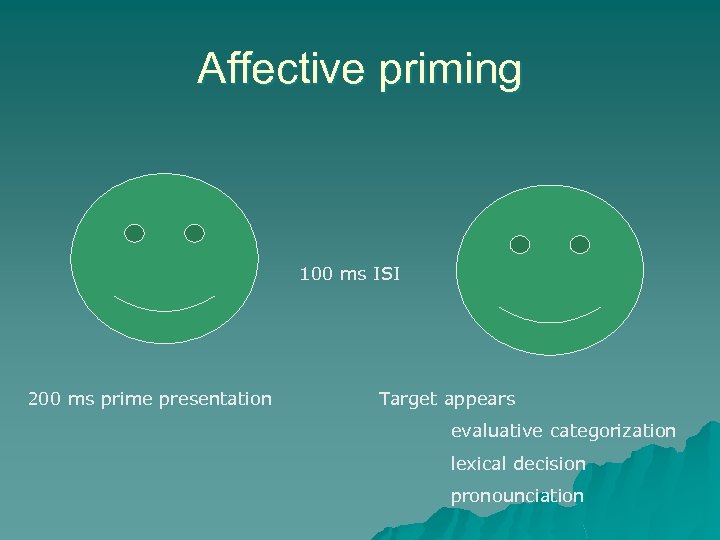 Affective priming 100 ms ISI 200 ms prime presentation Target appears evaluative categorization lexical decision pronounciation
Affective priming 100 ms ISI 200 ms prime presentation Target appears evaluative categorization lexical decision pronounciation
 Mental health
Mental health
 Therapy? u Normal and abnormal – Deviant – Maladaptive – Personal distress
Therapy? u Normal and abnormal – Deviant – Maladaptive – Personal distress

 Implicit cognition and therapy u Psychopathologies: – lack of intentional control – Irrational – Affectional in nature u Freud, TAT – More contamination – fakeable
Implicit cognition and therapy u Psychopathologies: – lack of intentional control – Irrational – Affectional in nature u Freud, TAT – More contamination – fakeable
 Cognitive models of anxiety u Maladaptive fear schema – More attentive to threatening cues – Interpretation of ambiguous situations – Automaticity of fear schemas u Explicit: not going to be fatally attacked by daddylonglegs u Implicitly: avoidance
Cognitive models of anxiety u Maladaptive fear schema – More attentive to threatening cues – Interpretation of ambiguous situations – Automaticity of fear schemas u Explicit: not going to be fatally attacked by daddylonglegs u Implicitly: avoidance
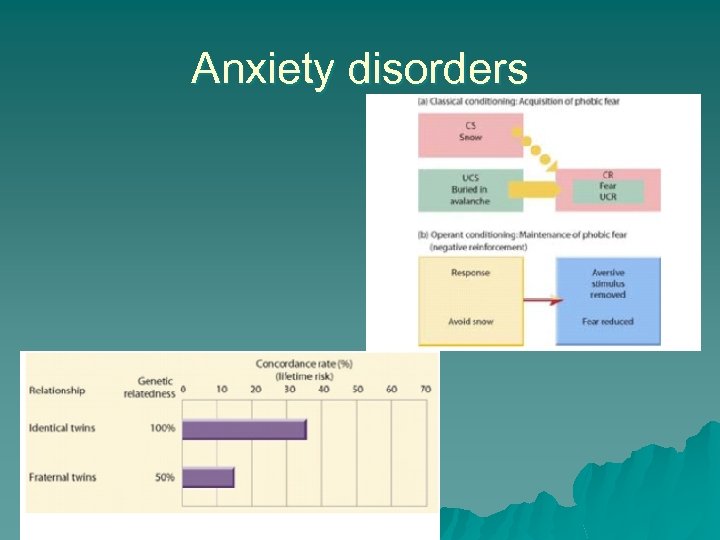 Anxiety disorders u Watson versus genetics
Anxiety disorders u Watson versus genetics
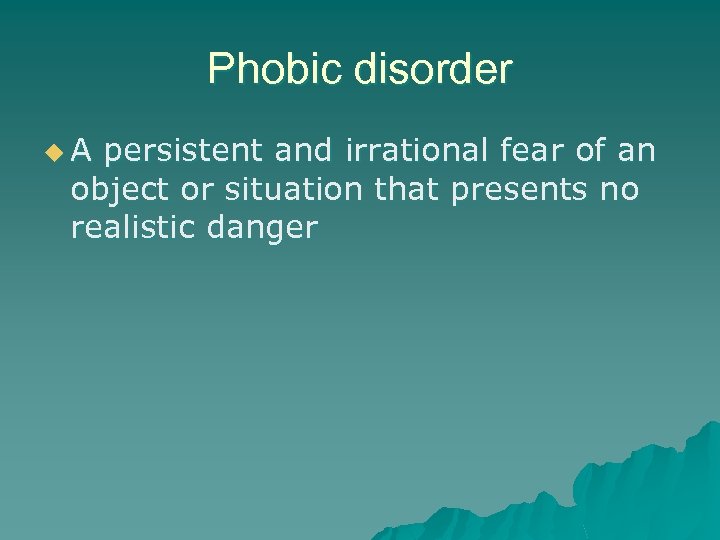 Phobic disorder u. A persistent and irrational fear of an object or situation that presents no realistic danger
Phobic disorder u. A persistent and irrational fear of an object or situation that presents no realistic danger
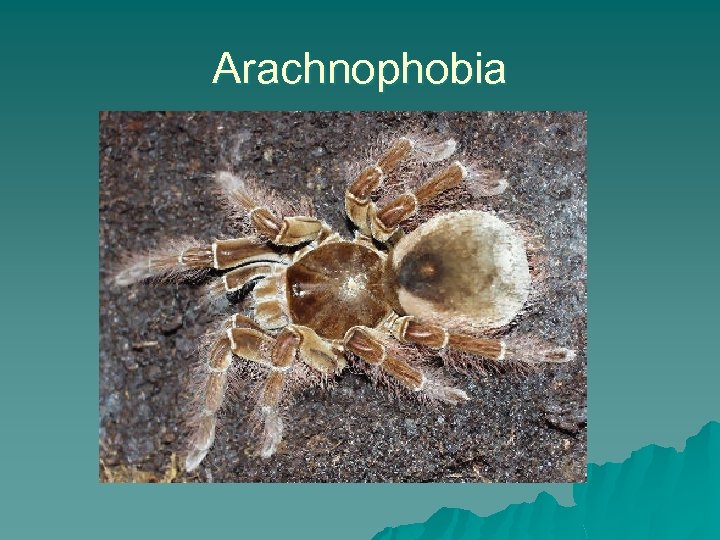 Arachnophobia
Arachnophobia
 Arachnophobia and IAT u There is no natural implicit opposing category to spiders – Snakes? – Household items? – Blood-injection? u Mixed results u Go-No. Go task
Arachnophobia and IAT u There is no natural implicit opposing category to spiders – Snakes? – Household items? – Blood-injection? u Mixed results u Go-No. Go task
 Go-no. Go task Has to answer quickly – otherwise it is not automatic – 1400 ms window
Go-no. Go task Has to answer quickly – otherwise it is not automatic – 1400 ms window
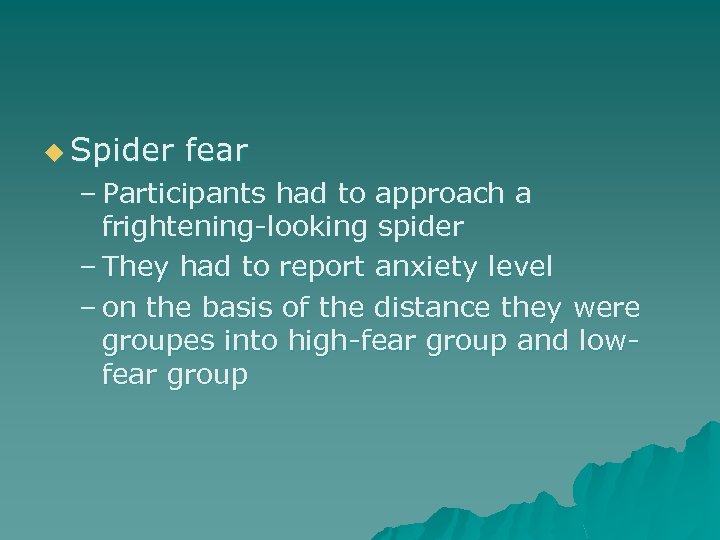 u Spider fear – Participants had to approach a frightening-looking spider – They had to report anxiety level – on the basis of the distance they were groupes into high-fear group and lowfear group
u Spider fear – Participants had to approach a frightening-looking spider – They had to report anxiety level – on the basis of the distance they were groupes into high-fear group and lowfear group


 Depression u Unipolar and bipolar
Depression u Unipolar and bipolar
 Mood disorders
Mood disorders

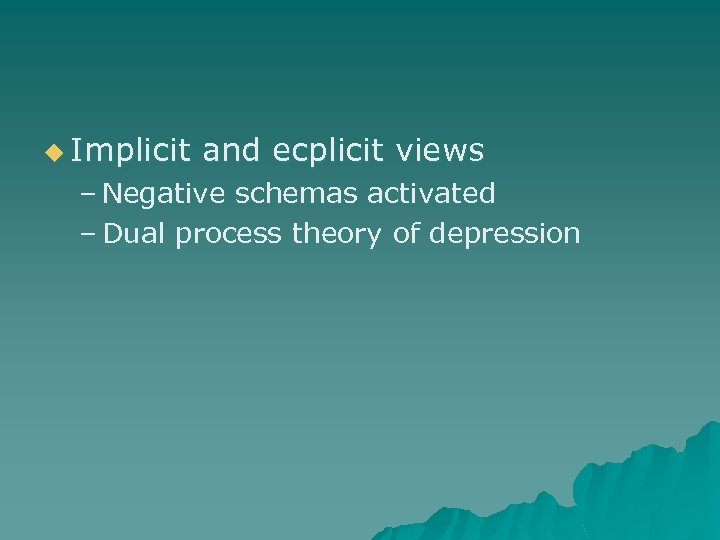 u Implicit and ecplicit views – Negative schemas activated – Dual process theory of depression
u Implicit and ecplicit views – Negative schemas activated – Dual process theory of depression
 u Questionnaires (explicit): – BDI – CSQ (Cognitive Style Questionnaire) – General distress Scale u IAT (Implicit) – Self (own name, personal data taken) – Positive adjectives
u Questionnaires (explicit): – BDI – CSQ (Cognitive Style Questionnaire) – General distress Scale u IAT (Implicit) – Self (own name, personal data taken) – Positive adjectives


 3 week follow-up
3 week follow-up

 Cultural variations u Main disorders everyhere – but with minor differences u Culture bound disorders Koro u – obsessive fear that one’s penis will withdraw into one’s an abdomen, seen only in Malaya and other regions of southern Asia. u Windigo – intense craving for human flesh and fear that one will turn into a cannibal, seen only among Algonquin Indian cultures u Anorexia nervosa – an eating disorder characterized by intentional self-starvation, until recently seen only in affluent Western cultures
Cultural variations u Main disorders everyhere – but with minor differences u Culture bound disorders Koro u – obsessive fear that one’s penis will withdraw into one’s an abdomen, seen only in Malaya and other regions of southern Asia. u Windigo – intense craving for human flesh and fear that one will turn into a cannibal, seen only among Algonquin Indian cultures u Anorexia nervosa – an eating disorder characterized by intentional self-starvation, until recently seen only in affluent Western cultures

 Religion
Religion
 u Attribution: percieved cause of action – Interoceptive sensations of bodily action – Attention: drawing attention either to self or others shifs attribution – Actor/observer effect (Jones and Nisbett) – The „mirror experiment” subjective and objective self-awareness (Duval and Wicklund) self-aware and environment aware. – Stigmas – social and linguistic u Dijksterhuis, A. et al. , EVects of subliminal priming of self and God on self-attribution of authorship for events, Journal of Experimental Social Psychology (2007), doi: 10. 1016/j. jesp. 2007. 01. 003
u Attribution: percieved cause of action – Interoceptive sensations of bodily action – Attention: drawing attention either to self or others shifs attribution – Actor/observer effect (Jones and Nisbett) – The „mirror experiment” subjective and objective self-awareness (Duval and Wicklund) self-aware and environment aware. – Stigmas – social and linguistic u Dijksterhuis, A. et al. , EVects of subliminal priming of self and God on self-attribution of authorship for events, Journal of Experimental Social Psychology (2007), doi: 10. 1016/j. jesp. 2007. 01. 003
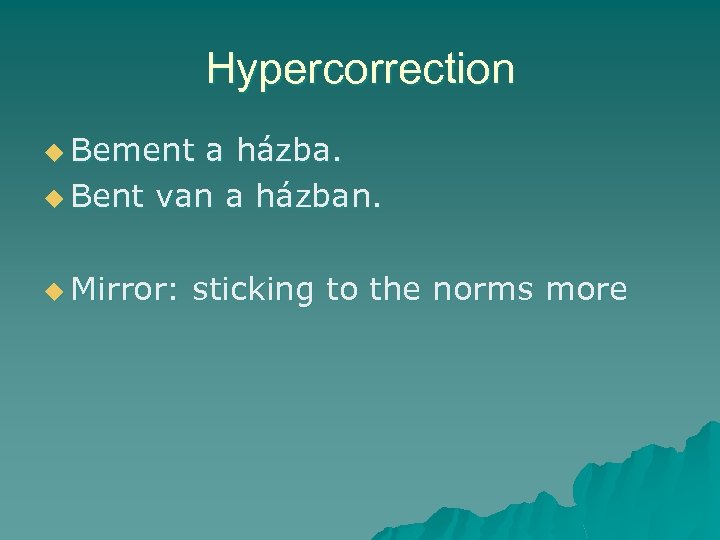 Hypercorrection u Bement a házba. u Bent van a házban. u Mirror: sticking to the norms more
Hypercorrection u Bement a házba. u Bent van a házban. u Mirror: sticking to the norms more
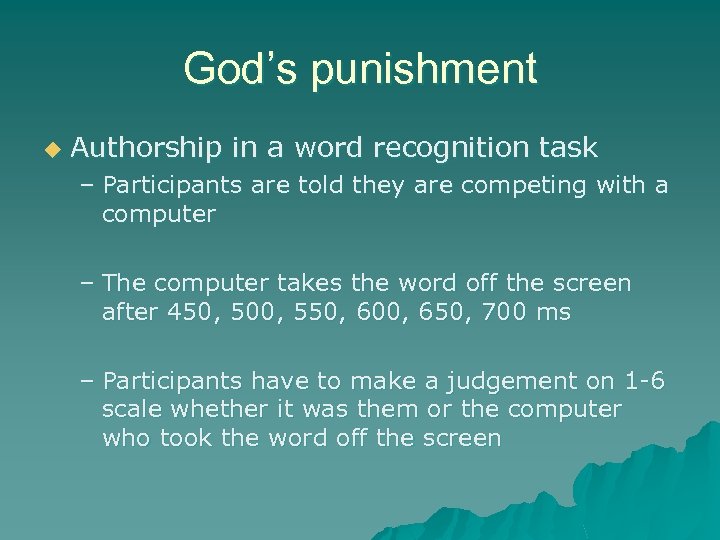 God’s punishment u Authorship in a word recognition task – Participants are told they are competing with a computer – The computer takes the word off the screen after 450, 500, 550, 600, 650, 700 ms – Participants have to make a judgement on 1 -6 scale whether it was them or the computer who took the word off the screen
God’s punishment u Authorship in a word recognition task – Participants are told they are competing with a computer – The computer takes the word off the screen after 450, 500, 550, 600, 650, 700 ms – Participants have to make a judgement on 1 -6 scale whether it was them or the computer who took the word off the screen
 17 ms prime 250 ms premask „me” „computer” „God” „the” „broccoli” „xxxxx” 50 ms postmask Target word Judgement task: was it you or the computer? (1 computer 6 me)
17 ms prime 250 ms premask „me” „computer” „God” „the” „broccoli” „xxxxx” 50 ms postmask Target word Judgement task: was it you or the computer? (1 computer 6 me)
 u No differences in lexical decision time
u No differences in lexical decision time
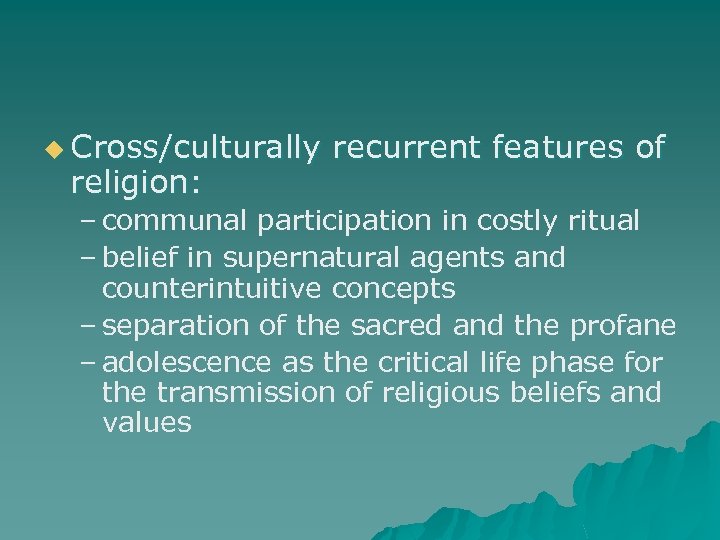 u Cross/culturally religion: recurrent features of – communal participation in costly ritual – belief in supernatural agents and counterintuitive concepts – separation of the sacred and the profane – adolescence as the critical life phase for the transmission of religious beliefs and values
u Cross/culturally religion: recurrent features of – communal participation in costly ritual – belief in supernatural agents and counterintuitive concepts – separation of the sacred and the profane – adolescence as the critical life phase for the transmission of religious beliefs and values
 costliness of religious activities u the four “B’s” – religious belief – behavior (rituals) – badges (such as religious attire) – bans (taboos) u Sosis, 2006: honest signals – costly religious demands are today increasing in many communities throughout the world! – kashrut (laws pertaining to edible food) among Ultra-Orthodox Jews are more stringent now than at any time
costliness of religious activities u the four “B’s” – religious belief – behavior (rituals) – badges (such as religious attire) – bans (taboos) u Sosis, 2006: honest signals – costly religious demands are today increasing in many communities throughout the world! – kashrut (laws pertaining to edible food) among Ultra-Orthodox Jews are more stringent now than at any time
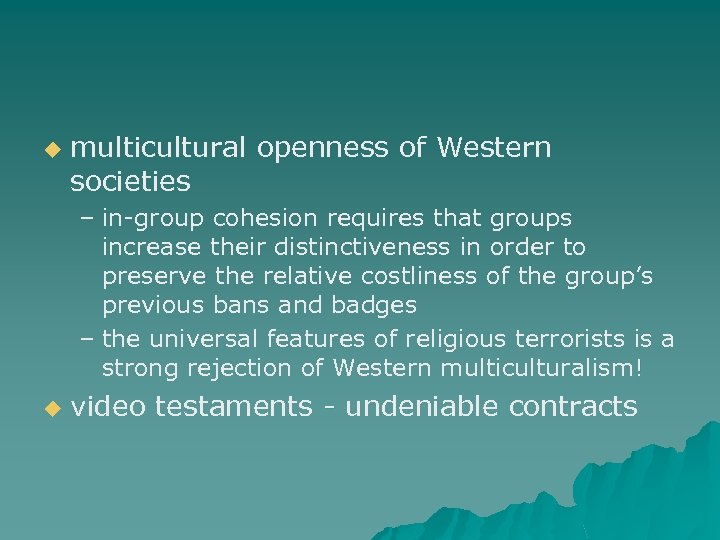 u multicultural openness of Western societies – in-group cohesion requires that groups increase their distinctiveness in order to preserve the relative costliness of the group’s previous bans and badges – the universal features of religious terrorists is a strong rejection of Western multiculturalism! u video testaments - undeniable contracts
u multicultural openness of Western societies – in-group cohesion requires that groups increase their distinctiveness in order to preserve the relative costliness of the group’s previous bans and badges – the universal features of religious terrorists is a strong rejection of Western multiculturalism! u video testaments - undeniable contracts
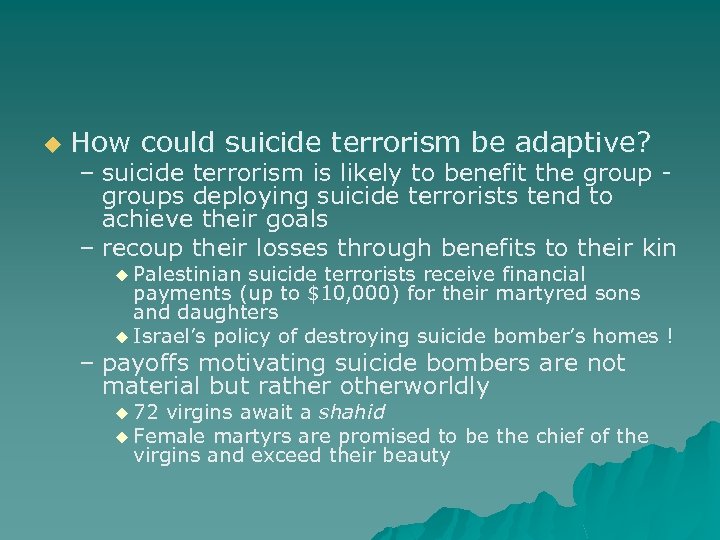 u How could suicide terrorism be adaptive? – suicide terrorism is likely to benefit the groups deploying suicide terrorists tend to achieve their goals – recoup their losses through benefits to their kin u Palestinian suicide terrorists receive financial payments (up to $10, 000) for their martyred sons and daughters u Israel’s policy of destroying suicide bomber’s homes ! – payoffs motivating suicide bombers are not material but rather otherworldly u 72 virgins await a shahid u Female martyrs are promised to be the chief of the virgins and exceed their beauty
u How could suicide terrorism be adaptive? – suicide terrorism is likely to benefit the groups deploying suicide terrorists tend to achieve their goals – recoup their losses through benefits to their kin u Palestinian suicide terrorists receive financial payments (up to $10, 000) for their martyred sons and daughters u Israel’s policy of destroying suicide bomber’s homes ! – payoffs motivating suicide bombers are not material but rather otherworldly u 72 virgins await a shahid u Female martyrs are promised to be the chief of the virgins and exceed their beauty
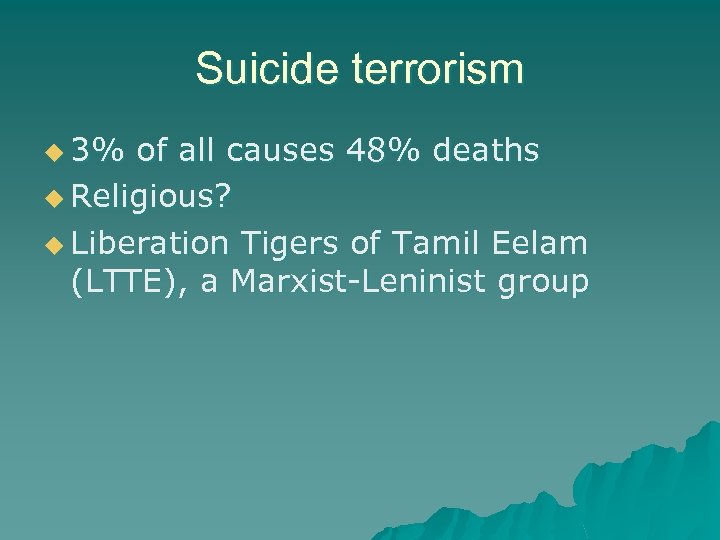 Suicide terrorism u 3% of all causes 48% deaths u Religious? u Liberation Tigers of Tamil Eelam (LTTE), a Marxist-Leninist group
Suicide terrorism u 3% of all causes 48% deaths u Religious? u Liberation Tigers of Tamil Eelam (LTTE), a Marxist-Leninist group
 False beliefs Palestinian suicide bombers have above average education and are economically better off than the general population u no evidence of psychopathology in an international sample of Muslim terrorists (not depressed) u religion is the means by which terrorists translate a local political struggle into a cosmic war – divine significance u
False beliefs Palestinian suicide bombers have above average education and are economically better off than the general population u no evidence of psychopathology in an international sample of Muslim terrorists (not depressed) u religion is the means by which terrorists translate a local political struggle into a cosmic war – divine significance u
 u Bin Laden – local grievance (getting U. S. troops off “Muslim” soil) into a cosmic clash between civilizations
u Bin Laden – local grievance (getting U. S. troops off “Muslim” soil) into a cosmic clash between civilizations
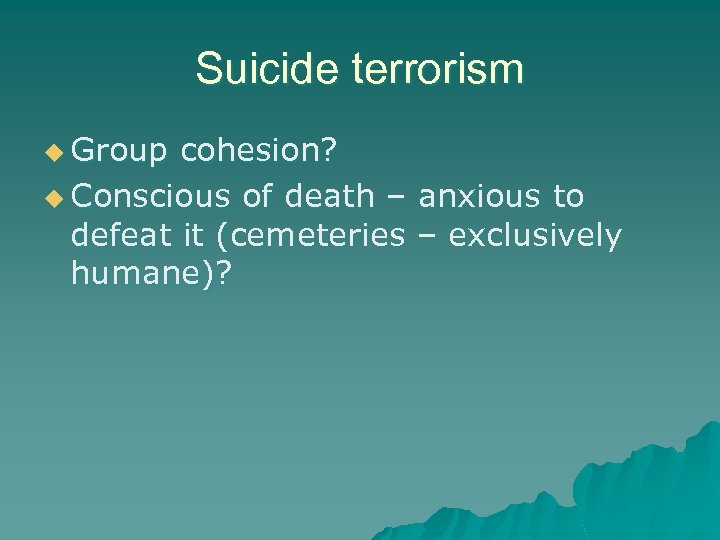 Suicide terrorism u Group cohesion? u Conscious of death – anxious to defeat it (cemeteries – exclusively humane)?
Suicide terrorism u Group cohesion? u Conscious of death – anxious to defeat it (cemeteries – exclusively humane)?


